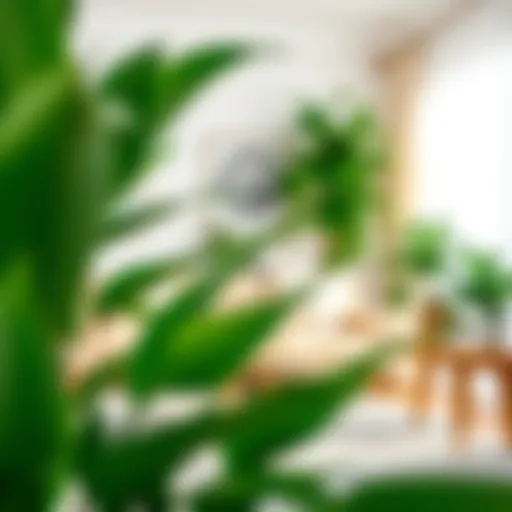The Multifunctional Benefits of Long Indoor Plant Pots
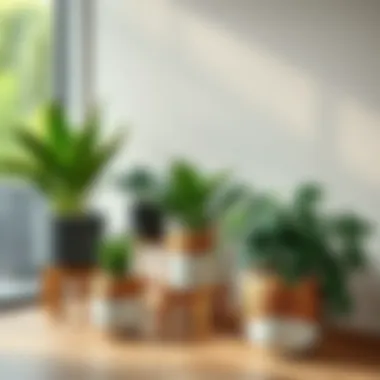
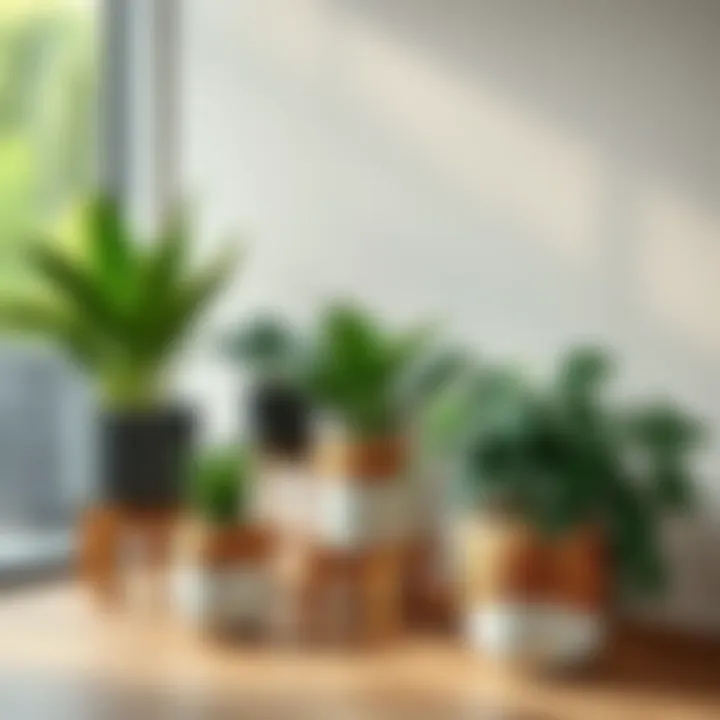
Intro
Indoor gardening has blossomed into a favorite pastime for many homeowners and design enthusiasts alike. The trend towards incorporating greenery into living spaces isn't just about aesthetics; it's about creating a harmonious environment that promotes well-being. One of the key players in this indoor jungle is the long plant pot, a versatile vessel that offers both style and functionality. These planters not only help in organizing plants but also elevate the ambiance of a room.
By focusing on long plant pots, we can explore their unique qualities—from types of plants that thrive in them to design trends that can impact your interior layout. There's much to uncover in terms of materials, styles, and maintenance tips that can help both novices and experts enrich their indoor gardens.
As we dive deeper into this topic, we will gain insights into how to choose the right planter for your space and which plants suit different decor styles. Whether you are looking to make a bold statement with modern designs or prefer a minimalist touch, long indoor plant pots have a place in every home.
Furniture Design Trends
When it comes to home decoration, the right piece of furniture can transform an entire room. Long indoor plant pots fit seamlessly into current design trends, serving as a striking accessory that adds character and sophistication.
Current Styles and Aesthetics
Long plant pots come in various styles, each serving a distinct design philosophy. From sleek, modern materials that reflect a contemporary vibe to more rustic finishes that evoke a sense of warmth, the choices are abundant. Here's a closer look at popular styles:
- Modern Minimalism: Simple lines and neutral colors define this trend. Pots made from materials like fiberglass or sleek ceramic can enhance a clean aesthetic.
- Industrial Chic: Think about concrete or metal pots, offering an edgy vibe that pairs well with urban environments.
- Bohemian Flair: Intricate patterns or earthy colors in terracotta or woven baskets can enliven a space with creativity and energy.
Color Palettes and Materials
Choosing the right colors and materials can accentuate your interiors. For instance, muted tones can create a sense of calm, while vibrant colors can serve as focal points in a room. Here are some popular palettes and materials:
- Earthy Tones: Shades of green, brown, and terracotta complement natural plants well.
- Bold and Bright: For a dramatic effect, look for pots in striking hues of blue, red, or yellow.
In terms of materials, consider the durability, weight, and appearance of your choices. Ceramic and hardwood pots offer a timeless look, while metal and fiberglass can provide a modern touch.
"Utilizing long plant pots in your decor is not just about housing plants—it's about creating a living, breathing space that reflects who you are."
As you explore the intersection of plant pot design and furniture trends, keep in mind the unique connection between color, material, and overall room aesthetic. With careful consideration, you can craft a space that feels cohesive and inviting.
Buying Guides
With so many options available, shopping for long indoor plant pots can be a daunting task. To simplify the process, it helps to know what to look for before making a purchase.
Essential Considerations When Purchasing
Here are several factors to guide your buying decisions:
- Size: Consider the plants you want to grow and their expected growth needs. Ensure the pot can accommodate them comfortably.
- Drainage: Look for pots with drainage holes to prevent overwatering, which can lead to root rot.
- Material: Choose pots that will suit both the plants and your interior design.
Top Recommendations for Different Budgets
Whether you’re on a budget or willing to splurge, there’s something for everyone. Here are some suggestions:
- Budget-Friendly: Terracotta pots are a great choice, offering durability and an organic look without breaking the bank.
- Mid-Range: Look into beautifully glazed ceramic pots that come in various colors and designs. They balance aesthetics and price well.
- Luxury Options: High-end stores often offer bespoke designs or premium materials like hand-crafted ceramics or elegant metallic finishes.
Aspects such as your personal style, plant types, and budget will significantly shape your shopping experience. The versatility of long indoor plant pots means there’s something out there that will suit every need and taste.
By keeping these design trends and purchasing tips in mind, you'll be better equipped to select the perfect long plant pots that resonate with your indoor gardening ambitions.
Intro to Long Indoor Plant Pots
When it comes to interior decorating, the right elements often make a world of difference. Long indoor plant pots are more than just vessels for plants; they serve multiple roles that can elevate your living spaces in unexpected ways. These pots are particularly designed for various environments, allowing homeowners and designers to add a touch of greenery where space is constrained.
First and foremost, long plant pots can optimize limited spaces. Picture a narrow windowsill or a tight corner; instead of being barren, it can flourish with lush greens. The elongated shape lends itself to creative arrangements — you can line them up or position them as a striking backdrop. This versatility isn’t just practical; it’s an art form that reflects your personal style.
In addition, long indoor plant pots can make growing taller plants a breeze. When arranged carefully, they let plants reach for the light without competing for the same surface area as traditional round pots. This encourages healthy growth, as plants enjoy having ample room to spread their roots.
Benefits and Considerations
One of the prime benefits of using long plant pots is their ability to create beautiful visual hierarchies in design. With choices ranging from sleek ceramics to rustic wood, you can enhance aesthetics without compromising function. Furthermore, they come with water reservoirs that help maintain moisture levels without constant attention. This can be particularly important for busy individuals who want to cultivate a green space without becoming overwhelmed by maintenance.
However, it’s essential to consider the types of plants that will do well in such containers. Not every species favors the narrow confines of a long pot. Researching plant selection ensures that each specimen has enough room to thrive, keeping your indoor garden vibrant and flourishing.
Conclusion of Preface
Therefore, understanding the relevance of long indoor plant pots goes beyond their appearance. It’s about leveraging their design to foster plant health and effectively use available space. In doing so, homeowners and designers alike can breathe life into their interiors, making every corner feel refreshing and alive.
Understanding the Functionality of Long Plant Pots
Long indoor plant pots are more than just containers for greenery; they serve various essential functions that enhance both plant health and indoor aesthetics. In this article, we will explore how these unique pots can be strategically utilized in ways that benefit both homeowners and plant lovers.
Optimizing Space Utilization
In many urban settings, space can be tight. Long plant pots offer a solution for making the most out of narrow areas. Think about a hallway or a windowsill – a traditional round pot might take up too much real estate, but a long planter can fit snugly against a wall without hogging the entire space.
Utilization of these pots can encourage creative layouts in interiors. You could effectively line them along a countertop or against a backdrop of shelves, adding dimension and life without overwhelming the room. One distinct advantage is their ability to accommodate multiple plants together. Grouping various plant species within a single long pot allows for dynamic combinations and creates a lush look without cluttering the visual space. When choosing a pot, consider its length and depth; a wider pot with good drainage is beneficial for root spread and can foster flourishing plant growth.
"Effective use of space is an art. Long pots allow for an impressive display while keeping it neat."
Encouraging Plant Growth
The functionality of long plant pots also extends into the arena of botanical health. Many plants, such as herbs and trailing varieties, thrive when given sufficient room for their roots to expand. A long planter caters to this need, providing ample soil volume, which not only promotes root development but also helps maintain an even moisture balance. This can be crucial, as uneven watering often leads to plant stress and poor growth.
In a long pot, the different microenvironments created by varying soil depths allow for diverse plant heights and types. For example, a pot with varied elevations can support taller plants in the center, with shorter varieties or ground covers surrounding them. This not just optimizes growth but also sets the stage for a harmonious arrangement. Adding organic matter to the soil, such as compost or rich potting mix, can significantly enhance fertility, providing essential nutrients that plants crave.
When it comes to watering, longer pots might require diligent attention to moisture, but they also present an opportunity to employ self-watering systems or moisture-retaining granules. These choices lead to healthier plants with less fuss, as the right conditions can naturally sustain growth.
In summary, understanding the functionality of long plant pots is key to transforming indoor areas into vibrant green spaces while maintaining a purposeful approach to space and plant care. This deeper comprehension can guide homeowners and designers in making informed, aesthetically pleasing choices, contributing to an enriched indoor environment.
Design Trends in Long Plant Pots
When considering indoor gardening, the design of the pots can be just as crucial to the overall aesthetic and functionality of the space. Long plant pots not only cater to plants with specific space requirements but also serve as dynamic design elements that can complement various interiors. By keeping an eye on current design trends, homeowners, designers, and DIY enthusiasts can select pots that harmonize with their surroundings while promoting healthy plant growth. This section delves into key design trends that make long plant pots appealing and functional.
Contemporary Aesthetics
In today's fast-paced world, contemporary aesthetics have taken a front seat in home decor, with simplicity and elegance being the guiding principles. Long plant pots fit seamlessly into this trend, often featuring clean lines and minimalistic designs that make them easy to incorporate into various styles.
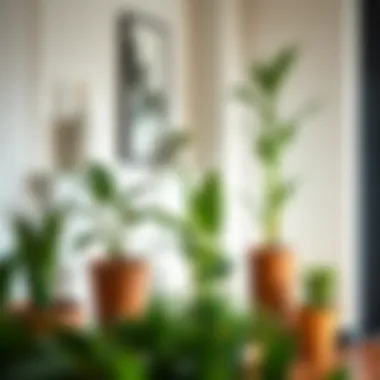
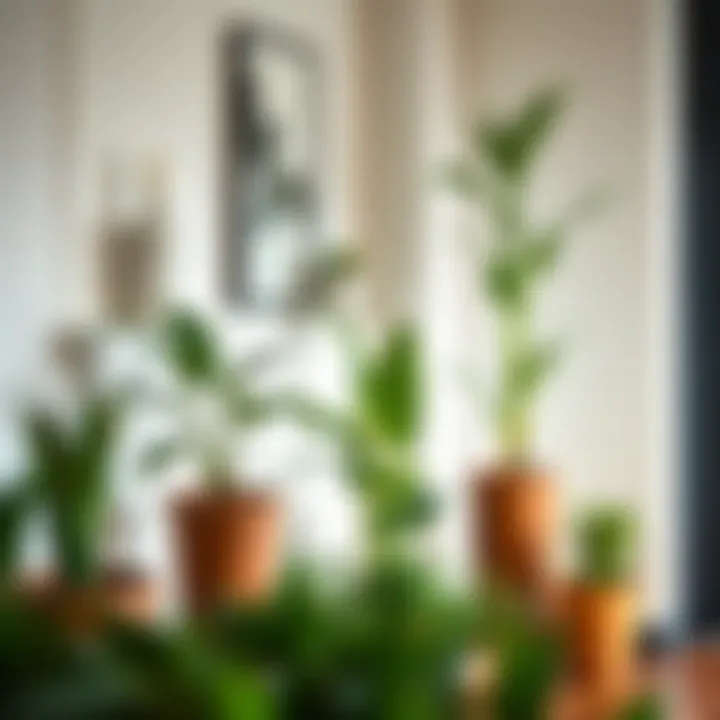
- Shapes and Sizes: You're likely to find long plant pots in various shapes and sizes, from sleek rectangular designs to elongated oval forms. This variety allows homeowners to play with proportions and space, using them as statement pieces or subtle accents. They work well in tight corners, along hallways, or even as dividers in open spaces.
- Color Palette: A muted color palette dominated by earth tones—like terracotta, beige, and muted greens—has gained popularity. These colors promote a soothing environment and help plants to stand out. Some designers opt for monochromatic schemes, pairing pots with the hues found in the plants themselves.
- Textural Elements: The integration of different textures adds depth to the decor. Notably, matte finishes, glossy glazes, or even textured surfaces create visual interest and draw the eye. A textured ceramic pot can create a beautiful contrast against the smooth leaves of a plant.
This contemporary approach emphasizes the combination of beauty and functionality. Long plant pots become integral parts of the room rather than mere containers for plants.
Natural Materials Versus Synthetic
Those exploring options for long plant pots often face the choice between natural materials and synthetic alternatives. Each category has its own merits and considerations, and understanding these can inform better purchasing decisions.
- Natural Materials: Some classic choices include ceramics, terracotta, and wood. These materials are often lauded for their breathable properties, which promote healthy root systems. For instance, terracotta can wick moisture away from soil, preventing overwatering. Additionally, wooden pots provide a rustic feel but may require more maintenance to ensure longevity.
- Synthetic Materials: On the flip side, synthetic materials like plastic or resin offer a lightweight and often more affordable alternative. They come in a wider array of colors and can mimic the appearance of natural materials, providing flexibility in design. Many modern synthetic pots are UV-resistant, which can be ideal for sunny indoor spots, and are often easier to clean, making them a practical choice for those who may not have the time or inclination to maintain more delicate materials.
However, there’s a growing movement towards sustainable synthetic options. Many manufacturers now create pots from recycled materials, which can reduce environmental impact without sacrificing quality.
In the quest for the perfect long plant pot, understanding the strengths of both natural and synthetic materials can lead to choices that are not only aesthetically pleasing but also environmentally responsible.
The choice between natural and synthetic materials ultimately boils down to personal preference and specific plant needs. A well-informed decision on this front can enhance the overall effectiveness of using long pots in indoor gardening.
Selecting the Right Plants for Long Pots
Choosing the right plants for long indoor plant pots can make all the difference in creating a harmonious and thriving indoor garden. The length of these pots allows for a more diverse selection of plants, promoting not just growth but also aesthetic appeal. It’s essential to consider how each plant will fit into the available space, as well as its unique needs regarding light, water, and soil. Let's delve deeper into the plants that work well in these elongated setups and the factors to keep in mind.
Best Plant Choices for Narrow Spaces
When selecting plants for narrow spaces, it's wise to look for varieties that grow upwards rather than outwards. For instance, upright plants like the Snake Plant, also known as Sansevieria, and ZZ Plant are perfect for long pots. They have a striking vertical presence that doesn’t encroach much on the surrounding area. Pothos is another excellent choice. With its trailing vines and ability to adapt, it could thrive beautifully in a long planter.
Consider also the Spider Plant. This hardy favorite not only elevates the room with its arching leaves but it's also forgiving towards novice plant caregivers. Here’s a quick rundown of plant choices:
- Snake Plant
- ZZ Plant
- Pothos
- Spider Plant
Each of these plants stands tall and proud in long pots, making them ideal candidates for optimizing your indoor space without sacrificing style.
Considerations for Plant Height and Spread
The height and spread of plants are critical factors when using long pots. Tall plants can effectively act as a backdrop for shorter ones, allowing for a layered and visually appealing display. For instance, placing a Dracaena in the back of a long pot could provide a robust and elegant height to the arrangement.
On the other hand, consider how much space each plant occupies horizontally. Some species might start off small but expand over time. The Ficus elastica, or rubber plant, can grow significantly, so it might be wise to place it in a spot where it has plenty of space to spread out without leading to overcrowding.
An ideal arrangement in a long pot might look like this:
- Back: Tall plants such as Dracaena or Ficus
- Middle: Medium-height plants like Pothos or Peace Lily
- Front: Low-growing varieties such as Spider Plant
"Selecting plants based on their height and spread allows for a balanced and thriving indoor garden that catches the eye and draws attention."
When all’s said and done, picking the right plants for long pots isn’t just about what looks good. It’s about creating a balanced and harmonious indoor environment that improves air quality and aesthetics all at once.
Material Options for Indoor Plant Pots
In the realm of indoor gardening, choosing the right material for plant pots is more than just a matter of aesthetics. The material impacts everything from how well the plants thrive to how the pots blend with interior decor. Each option comes with its particular set of attributes, making it essential for homeowners and designers alike to understand the subtle nuances. This section will unravel the benefits and considerations of the most common materials used for long indoor plant pots, ensuring a well-rounded perspective.
Ceramics and Their Benefits
Ceramic pots are often seen as the classic choice for many gardeners. Their appeal lies not only in their varied colors and designs but also in their ability to promote healthy plant growth. Ceramic is notably breathable; this means it allows for better air circulation around the soil, which can be a game-changer for root health. Furthermore, ceramics retain moisture, helping to keep plants hydrated longer, which is particularly beneficial for those who may sometimes forget to water their greenery.
However, weight can be an issue. A hefty ceramic pot might not be ideal for someone who loves rearranging their space frequently. Additionally, they can crack if exposed to drastic temperature changes.
- "Choosing the right pot material impacts your plants' health and your home's aesthetics."
Plastic and Its Practicality
Plastic pots are the unsung heroes of indoor gardening, especially when practicality is at the forefront. They are lightweight and often come at a lower price point, making them accessible for many. These pots can easily be moved around to catch the right light, and they won’t break if accidentally dropped. Moreover, plastic holds moisture comparatively well, which can aid in retaining the necessary humidity for specific plant types.
On the flip side, plastic doesn't allow for as much airflow as ceramics do. Consequently, this can lead to root issues if plants are overwatered. It's important to stay mindful and perhaps enhance drainage by using appropriate soil mixes or including drainage holes.
Wooden Pots and Aesthetic Value
Wooden pots exude a certain elegance that is hard to replicate with other materials. They bring a rustic charm to indoor spaces that many homeowners find appealing. Additionally, wood is a natural insulator; it helps regulate soil temperature, keeping it warmer in winter and cooler in summer. This temperature regulation can be crucial for the health of certain plants that thrive in specific temperature ranges.
However, wooden pots do require some care. They can rot if exposed to excessive moisture or poor drainage, and they may need to be treated with sealants to enhance durability. Designers often recommend wooden pots when aiming to create a warm, inviting atmosphere, especially in combination with earthy tones or natural decorations.
Understanding the properties of materials is key to making informed choices when selecting long indoor plant pots. It's all about aligning the right pot with your lifestyle and the specific needs of your plants, ensuring both aesthetic satisfaction and botanical health.
Placement of Long Plant Pots in Indoor Environments
In the realm of interior design, the placement of long plant pots plays a significant role in enhancing not only the aesthetic appeal of a space but also the overall health of the plants within. Smart placement strategies maximize the benefits of these elongated containers, directing attention to their beauty while also considering the needs of the plants. This section delves into the various strategies for placing long indoor plant pots, focusing on how light access can be optimized and how these pots can serve as captivating focal points in your décor.
Strategic Positioning for Light Access
One of the most vital considerations when placing long plant pots indoors is ensuring that the plants receive adequate light. Most plants have specific light requirements that can greatly influence their growth and health. Positioning pots where they can soak up the maximum amount of natural light is key. Here’s how to go about it:
- Orientation Towards Windows: Arranging your long plant pots close to windows allows the plants to benefit from the sunlight. South-facing windows are typically the most beneficial, as they receive direct sunlight for a larger portion of the day.
- Utilizing Light Shelves: If floor space is tight, consider using shelves to place the pots higher up, where they can capture more light while keeping floor areas free.
- Rotation Technique: Rotate the position of your pots periodically to ensure all sides of the plant get equal light exposure. This is essential for preventing uneven growth.
Placing long pots strategically for light isn't just about maximizing growth potential; it also creates a more visually engaging environment. Well-lit plants tend to appear more vibrant, enriching the overall ambiance of the space.
Creating Focal Points in Design
Long plant pots can easily become focal points in your indoor setting, acting as eye-catching elements that draw attention and unify various design aspects in a room. Here’s how to effectively create these focal points:
- Group Plant Pots Together: Arrange multiple long pots in various heights and textures to create a visual tapestry that captures the eye. This can lead to a stunning interplay of shapes and colors.
- Incorporate Height Variations: Adding height variations can stir interest. Taller pots could stand at the back or sides, while shorter ones might be placed in front, creating depth and inviting viewers to explore the arrangement.
- Complement Existing Decor: When selecting pots, consider their finishes and colors. Choose designs that harmonize with your existing decor while still allowing the plants themselves to pop. A wooden pot can add warmth to a modern setting, or a glossy ceramic might bring a sleek look to a minimalist space.
By placing long plant pots with intention, you’re not merely adding greenery but crafting an experience. The incorporation of plants as design elements enhances the indoor landscape, making any room feel more alive and welcoming.
"Plants bring life and energy to interiors, and their presence in thoughtfully placed long pots can transform a drab space into a vibrant haven."
Maintenance of Long Indoor Plant Pots
Taking care of long indoor plant pots is more than just a routine chore—it plays a critical role in ensuring the health of your plants and the longevity of the pots themselves. When you invest time in maintaining these planters, you’re not only fostering a thriving indoor garden, but you're also maximizing the aesthetic appeal of your space. Regular upkeep keeps the plants vibrant, enhances the decor, and can even save you from spending money on replacements or new plants due to neglect.
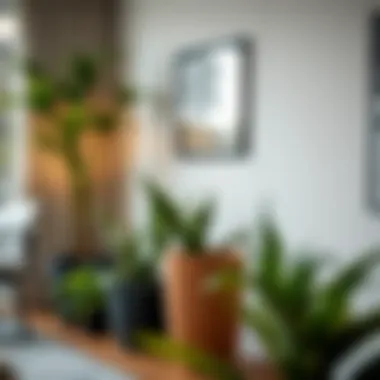
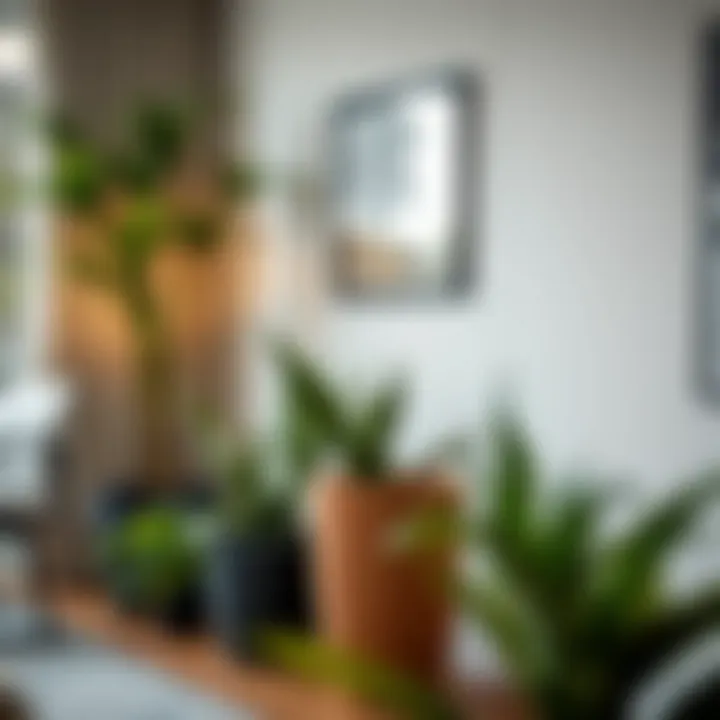
Here are some essential elements to consider in maintaining long indoor plant pots:
- Regular Water Management: Finding that sweet spot with watering can be tricky, especially in long pots that may have uneven moisture levels.
- Soil Health: The type and condition of soil significantly affect plant growth. Long pots can make it challenging to see when soil needs replenishing.
- Cleaning of Pots: Dust or residue build-up can harm the plants' health and may hinder their growth.
- Plant Rotation: Regularly changing the position of plants within the pots can prevent competition for light and nutrients and encourage more balanced growth.
Understanding these maintenance factors helps create a thriving indoor garden that can last through the seasons.
Watering Techniques for Long Pots
Watering long plant pots requires a slightly different approach compared to traditional pots. The shape and size of these planters often mean that moisture retention can vary greatly within the pot, and some plants may struggle for moisture while others are soaked. Here are some tactics:
- Moisture Assessment: Before you water, always check the soil moisture level by sticking your finger about an inch into the soil. If it feels dry at your fingertip, it's time to water.
- Slow Watering Method: Pour water slowly into the pot. This helps ensure it seeps evenly into the soil.
- Use a Watering Wand: This tool allows for precision watering into the narrow sections of long pots, helping you to reach each plant's roots effectively.
"Regularly checking moisture levels can help prevent overwatering or underwatering, extending the life of your plants and pots."
Soil Composition and Fertility
The choice of soil composition is crucial when it comes to the maintenance of long indoor plant pots. Different plants have different soil needs, and understanding these requirements will help you take better care of your greenery.
Key aspects to consider include:
- Drainage Capability: Long pots benefit from a soil mix that drains well; using potting soil mixed with perlite or coarse sand can promote better drainage.
- Organic Matter: Incorporating organic compost can improve soil fertility and support robust plant growth, making your plants healthier and more vibrant.
- Nutrient Levels: Depending on the plants you're housing, you may need to amend the potting soil with fertilizers to ensure they receive adequate nutrients throughout their growth cycle.
By focusing on proper soil composition and regularly replenishing nutrients, you set the stage for lush plant growth and a thriving indoor environment.
The Role of Long Plant Pots in Air Quality
Long indoor plant pots play a crucial role in enhancing indoor air quality, an aspect often brushed off as secondary to aesthetics or plant variety. The growing concern over indoor pollution highlights why understanding the relationship between plant pots and air quality is essential. When strategically placed, these pots can not only beautify a space but also improve air cleanliness, making homes healthier and more inviting.
The influence of indoor plants on air quality can be boiled down to their ability to purify the air. Plants absorb carbon dioxide and release oxygen, but their role doesn't stop there. They can also filter out harmful toxins, increase humidity, and even reduce stress levels in occupants. Consequently, selecting the right plants for long pots can magnify these benefits exponentially.
Plants That Improve Indoor Air Quality
Identifying plants that effectively improve indoor air quality can feel like navigating a maze, yet certain species consistently rise to the top for their air-purifying qualities. Here are some notable contenders:
- Snake Plant: This hardy plant is well-known for its capability to convert CO2 into oxygen at night, enhancing bedroom air quality.
- Peace Lily: Renowned for its stunning white blooms, the peace lily also removes toxins such as ammonia and formaldehyde from the air.
- Spider Plant: Eager to flourish in a variety of light conditions, spider plants excel at filtering out carbon monoxide and other pollutants.
- Pothos: With its trailing vines, pothos not only decorates but also absorbs indoor toxins, including benzene.
Featuring these plants in long pots maximizes their potential to cleanse air while also utilizing vertical space effectively. When clustered together, they form a lush green screen, proving functional and visually appealing.
Scientific Insights on Air Purification
Research into how plants impact air quality offers some enlightening revelations. A study by NASA back in the late 1980s sparked interest in the notion of houseplants as air purifiers. They identified several species capable of filtering hazardous volatile organic compounds (VOCs)—chemicals often found in household products and building materials.
- VOCs and Their Impact: Exposure to VOCs can lead to various health issues, including headaches and respiratory problems. Having plants like those mentioned above in your long pots can significantly mitigate these risks.
- Soil Microorganisms’ Role: It's not just the plants themselves that contribute to air purification; the soil also plays a vital role. Microbial activity in the soil helps break down pollutants, further cleaning the air around us.
- The Science of Humidity: Plants transpire, meaning they release moisture into the air. This natural process can help alleviate dry indoor conditions that are increasingly common in modern homes due to heating and air conditioning.
In short, incorporating long plant pots filled with the right plants can act as a natural remedy against poor air quality. Integrating these pots into your living spaces doesn’t just make it prettier; it actively contributes to enviable Indoor Air Quality (IAQ).
"A room with plants is not just a visual treat; it's an investment in your well-being."
For further reading on the importance of indoor air quality and how plants contribute to it, you may check resources like EPA and NIH.
In sum, air quality is an essential aspect of indoor living, and long plant pots can be a tremendous ally in enhancing it.
Customization in Long Plant Pots
Customization is a crucial aspect of long indoor plant pots, representing an intersection of personal expression and functional design. Through customization, homeowners and design enthusiasts can create unique arrangements that reflect individual styles, enhance home aesthetics, and cater to specific plant needs. The significance of personalization in this realm lies not just in beautifying indoor space but also in optimizing the conditions for plants to thrive.
Investing time and creativity into customizing plant pots fosters a deeper connection with nature, giving the space character and warmth. This can range from selecting pots that complement existing decor to incorporating personal flair through colors, patterns, or textures. Moreover, customized plant pots can reflect cultural significance, showcasing a blend of traditions and modernity in indoor gardening.
Personalizing Designs for Individual Spaces
Personalization allows for practical adaptations to the unique layouts of various indoor spaces. Understanding the dimensions of your home can influence not only the size of the pot but also its shape and color. For those with narrower windowsills or less conventional layouts, selecting elongated pots can make a world of difference.
- Consideration of Colors and Materials: Different colors and finishes can significantly impact the ambiance of a room. A sleek, metallic finish may suit a modern kitchen, whereas earth-tone clay pots might complement a rustic living room.
- Practicality Meets Aesthetics: When choosing textures and designs, practicality should match aesthetics. Designs that are easy to clean and maintain ensure that the pots look good for longer, making them a sensible choice for homeowners.
By infusing personality into long plant pots, one does not only enhance their home visually but also creates a welcoming environment that encourages growth—in both plants and residents alike.
DIY Long Plant Pot Projects
For those who enjoy hands-on activities, engaging in DIY projects related to long plant pots offers a rewarding experience that combines artistry and practicality. Creating custom plant pots allows individuals to showcase their creativity while ensuring that the pots fit perfectly into their unique spaces. This practice can be as simple or intricate as one chooses.
Some interesting DIY ideas include:
- Upcycling Old Containers: Transforming old wooden crates or metal boxes into chic planters can add a rustic touch to any room while reducing waste.
- Painting and Decorating: Using non-toxic paints, you can personalize plain pots with patterns, stencils, or even decoupage techniques. This makes the pots not just functional, but a real statement piece in your room.
- Creating Vertical Gardens: For limited spaces, consider building a vertical plant pot system. This approach not only saves space but also adds a dynamic visual element to an otherwise ordinary wall.
"Customization breathes life into every inch of our indoor spaces, turning mere pots into reflections of our stories."
Engaging in these projects allows a sense of ownership over the plants and their environment, promoting a better relationship with nature. Whether it’s a small touch of paint or a completely reimagined planter, each effort to customize long indoor plant pots can become a beautiful part of the home narrative—each telling a story as vibrant as the plants they cradle.
Long Plant Pots Versus Traditional Pots
When it comes to the world of indoor gardening, the choice between long plant pots and traditional pots often sparks discussion among enthusiasts and homeowners alike. Each type offers unique advantages that can significantly affect the aesthetics and functionality of an indoor space. Long pots, characterized by their elongated shape, are especially valuable for optimizing narrow spaces and promoting plant growth. Conversely, traditional pots come in a variety of shapes and sizes, which have their own sets of benefits.
Comparative Analysis of Benefits
Long Plant Pots provide a specific edge when it comes to space management and planting options. Their elongated structure helps in beautifully showcasing plants that tend to spread out, like trailing vines or herb bushes. This design not only facilitates better air circulation among the plants but also encourages healthier growth. More importantly, long pots can house multiple plants which helps save valuable floor space, ideal for urban dwellings where every inch counts.
Some perks of using long plant pots include:
- Efficient Use of Space: Multiple plants can flourish in one pot, which is perfect for compact environments.
- Enhanced Aesthetics: Long pots can create striking visual lines that draw the eye, serving as landscape features in any room.
- Improved Water Management: Their design allows for more uniform water distribution, reducing the chances of root rot or uneven growth.
On the other hand, Traditional Pots shine in terms of simplicity and variety. They are available in multiple sizes, allowing for creative flexibility in arranging different plants. Here are some of the benefits of traditional pots:
- Variety of Shapes and Colors: The options are nearly limitless—from rounded terracotta to sleek ceramic designs, enabling personalized decor styles.
- Appropriate for All Plant Types: Traditional pots can accommodate just about any plant, providing the depth needed for root growth in larger species.
- Ease of Weight Management: For those who frequently move their plants, traditional pots might prove easier due to various weight materials available.
Thus, the decision between long and traditional pots often hinges on personal preferences regarding space, aesthetics, and the specific plants being cultivated.
Design Considerations for Each Type
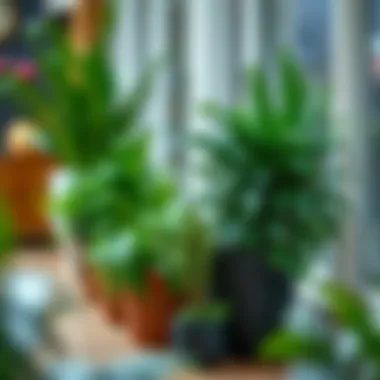
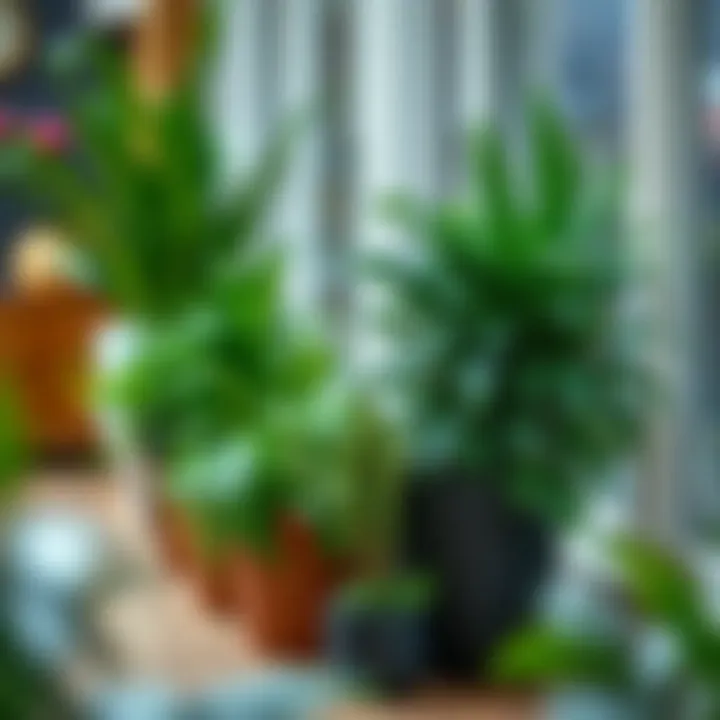
When considering long plant pots versus traditional pots, a few design elements must not be ignored.
For long plant pots, their slim profile can create stunning low lines across shelves or counters. Ensure that the chosen pot not only complements your existing decor but also allows for adequate drainage. Opting for a thin, lightweight material, like modern plastics, can also mean easy movement.
On the flip side, with traditional pots, the focus can shift to colors, textures, and historical value. For a warm, rustic vibe, terracotta or rough-hewn ceramic pots can shine bright. However, choosing a pot with a drainage system is equally crucial as it aids in maintaining soil health.
Ultimately, your choice should reflect not just your personal style but also the needs of your plants. The right pot, whether long or traditional, enhances your indoor garden's overall quality, making it a sanctuary of serenity and life.
"The uniqueness of your indoor garden lies not just in the plants you choose, but in the pots that cradle them."
Cultural Significance of Indoor Plants
In the age we live today, indoor gardening is not merely a hobby; it has become a meaningful avenue for self-expression, connection to nature, and overall well-being. Specifically, long indoor plant pots, often nestled in corners of our homes or prominently displayed on shelves, serve not just as containers but as canvases for cultural stories and personal aspirations. Growing plants within these vessels can carry forward traditions, evoke memories, and create vibrant living spaces that reflect individual tastes. It’s a practice that transcends generations, fostering a sense of belonging and identity.
Historical Context of Indoor Gardening
The roots of indoor gardening stretch way back in time. In civilization's early days, people cultivated plants in their homes not solely for beauty but for practical benefits. Ancient Egyptians, for instance, utilized herbs in pots to both flavor their food and ward off pests—an important consideration in a time when modern conveniences were nonexistent. The Romans took this a step further, introducing the concept of decorative vases that showcased their wealth and cultural significance.
Interestingly, as gardens became more private, indoor plants began to symbolize refinement. The Victorian era saw a surge in houseplant popularity. Those ornamental pots were not just vessels; they were status symbols. Wealthy families often showcased exotic plants transported from distant lands, serving as representations of exploration and affluence. This historical connection enriches our modern understanding of indoor gardening, encouraging homeowners and designers to appreciate the cultural narratives behind each pot and plant.
Modern Trends in Urban Gardening
In today's fast-paced urban lifestyle, indoor gardening has found a unique identity. Long plant pots have become synonymous with minimalism, eco-friendliness, and creativity. The trend of vertical gardening has taken hold, with long pots making optimal use of limited space, particularly in apartments where square footage is at a premium. This shift aligns with a broader movement towards sustainability, where individuals increasingly want to know where their food is coming from and how they can contribute to a greener planet.
Moreover, urban gardening reflects a collective desire to reconnect with nature amid concrete jungles. Social media platforms buzz with pictures of lush indoor gardens where long plant pots display a range of greens, promoting wellness and cleanliness. Homeowners appreciate how these plants not only beautify a dull corner but also offer psychological benefits. The act of caring for plants helps reduce stress and encourages mindfulness in a culture characterized by hustle and bustle.
"Urban gardening isn’t just a fad; it’s a testament to our resilience and adaptability in the face of modern challenges."
In sum, the cultural significance of indoor plants, especially those housed in long pots, goes deeper than aesthetics. It touches on histories, personal stories, and the emerging trends that speak to our collective human experience. Whether it’s for decorative purposes or the quest for a healthier home environment, these pots play an integral role in shaping our indoor landscapes and our lives.
Sustainability in Long Plant Pot Production
In recent years, the concept of sustainability has taken center stage in various industries, and indoor gardening is no exception. When we talk about long plant pots, it’s crucial to consider not just their design and functionality, but also how they’re made. Sustainability in long plant pot production isn't merely a buzzword; it's a necessity that can have a profound impact on both our environment and our indoor spaces.
First off, there are significant environmental benefits to choosing sustainably produced plant pots. Long pots made from renewable resources help reduce carbon footprints. When materials like bamboo, reclaimed wood, or biodegradable composites are used, the waste generated in production diminishes greatly. This aligns with a growing awareness among homeowners and designers about eco-friendly choices in their decor. Choosing pots with sustainability in mind means supporting eco-conscious brands that are dedicated to responsible sourcing.
Moreover, sustainable practices enhance healthier indoor environments. Many pot materials can emit harmful VOCs (volatile organic compounds) found in traditional plastics or untreated wood. Opting for sustainably produced pots minimizes this risk, ensuring that the air quality in our homes remains fresh and clean.
To underline these aspects, let’s look at the crucial subcategories involved in sustainability:
Ethical Sourcing and Materials
When discussing sustainability, it's essential to highlight ethical sourcing. This refers to the methods by which materials are obtained, fundamentally focusing on fairness to workers and the environment. For instance, some manufacturers focus on local sourcing, which not only reduces transportation emissions but also supports the local economy. Using certified materials, like those from the Forest Stewardship Council (FSC), assures consumers that their pots come from responsibly managed forests.
Additionally, the production methods chosen play a pivotal role. For example, certain techniques minimize the use of toxic substances in the manufacturing of plant pots, ensuring a reduced environmental impact. When long pots are crafted from recycled materials, this cycle of reuse helps to further lower the demand for virgin resources, fostering a culture of conservation. Homeowners and designers now have the opportunity to choose products that embody ethical practices while enhancing their living spaces, promoting a conscious approach to interior design.
Impact of Recyclable Materials
Integrating recyclable materials into long plant pot production represents a significant leap towards sustainable gardening. Pots that can be entirely recycled—whether they’re ceramic, metal, or biodegradable plastic—are beneficial in two major ways. Firstly, these materials help divert waste from landfills. When a pot reaches the end of its life, if it’s made from recyclable materials, it can be remade into something new instead of becoming a part of waste that lingers in landfills for centuries.
Secondly, using recycled content often requires less energy than producing new materials, which means a lower carbon output. For example, pots made from recycled glass can be crafted without the need for extensive heating, thus saving energy and resources in the process. This transition towards the use of recyclable materials isn’t simply about making pots—it's about creating a sustainable future for indoor gardening.
"Sustainability isn’t a choice anymore; it’s an essential pathway to a healthier planet. By choosing wisely, each pot contributes to this larger goal."
To wrap up, integrating sustainability into long plant pot production addresses many contemporary concerns. As more homeowners and designers seek to align their practices with eco-friendly values, making informed choices about the materials and sourcing of long plant pots can foster an environment that is beneficial for both our homes and the planet. Each of these efforts adds up, promoting a culture of sustainability that is essential for future generations.
Future Trends in Indoor Plant Pots
The increasing popularity of long indoor plant pots is not just about aesthetics; it intertwines with innovative design and advanced technology. As more homeowners and designers lean toward greenery in interiors, understanding future trends is crucial for selecting the right planter. This section can guide you through the evolving landscape—indicating what kinds of designs, materials, and functionalities to expect as we propel into the future of indoor gardening.
Innovations in Design and Functionality
In the realm of long plant pots, innovative designs are emerging that prioritize functionality while being visually pleasing. Gone are the days when aesthetics stood solely on ceramic or glazed finishes. Today, contemporary designers are creating pots that use smart materials, such as self-watering systems that regulate moisture levels. With advancements in manufacturing techniques, pots can now incorporate textured surfaces, intricate patterns, and even vibrant colors tailored for every taste. These innovations do not just spice up your living space, but they enhance the experience of caring for indoor plants.
Benefits of Innovative Designs:
- Space Efficiency: Many contemporary pots feature vertical designs or modular configurations allowing for the arrangement of more plants in tighter spaces.
- Functional Features: Self-watering pots, integrated drainage systems, and lightweight materials make plant care more manageable.
- Stylistic Variations: Diverse colors and textures allow homeowners to express personal style that complements their overall decor.
Materials to Keep an Eye On:
- Biodegradable Plastics: As more people aim for sustainability, pots made from biodegradable materials are gaining traction. They offer a guilt-free option for eco-conscious plant lovers.
- Smart Pots: These often come with technology to monitor soil moisture levels and light, adjusting conditions to optimize plant growth.
The Role of Technology in Plant Care
Embracing technology in indoor plant care is reshaping the approach to gardening. From smart irrigation systems that connect to your smartphone to sensors that inform you when to water your plants, technology is enhancing our ability to maintain healthy plants without defecting to mundane routines. Homeowners can now enjoy the benefits that come with a modern touch, helping to keep flora thriving in a busy lifestyle.
For instance, the use of apps that manage indoor gardens has exploded. These applications assist in everything from scheduling watering to categorizing plant growth stages—from seedling to maturity, ensuring that you stay on top of the watering schedules and sunlight needs of every plant you adopt.
Emerging Technological Trends:
- Automated Plant Care Systems: Devices that automatically water and monitor nutrients are becoming more prevalent, with some systems even allowing for remote management via smartphone.
- Augmented Reality (AR): AR technology can pave the way for virtual gardening, allowing users to visualize how a particular plant might look in a given space before committing.
- Community Sharing Platforms: Innovations delivering platforms that connect plant enthusiasts can make sharing tips, plants, and even design ideas easier than ever.
"The future of indoor gardening is a blend of nature and technology, ensuring that every green thumb—be it novice or expert—can enjoy their hobby without the hassle of traditional care."
As we look toward these trends, it's essential for homeowners, designers, and DIY enthusiasts to stay informed and open to these developments. This insight into future plant pot technologies will not just have them sprucing up their spaces but also enhance their connection with the natural elements they choose to nurture.
Finale
In closing, the discussion surrounding long indoor plant pots encapsulates a variety of crucial elements that contribute to enhancing both aesthetics and functionality within living spaces. These pots are not merely vessels for plants; they serve as foundational components that define interior décor while promoting a healthier indoor environment.
One significant benefit of long plant pots is space efficiency. In environments where square footage is at a premium, these elongated pots offer an elegant solution for maximizing greenery without bulky frames obstructing walking paths or sight lines. This is particularly beneficial in urban settings where living spaces often come with challenges associated with size and layout.
Moreover, selecting the right plants for these pots can create stunning displays. It’s about more than just filling a container; it’s about understanding the growth habits of plants and how they interact. For instance, utilizing cascading varieties adds visual depth and character, transforming a simple planter into a thriving display. Homeowners and designers can mix and match plant types, crafting an appealing visual narrative.
Maintenance is another vital consideration. Long indoor pots can be more forgiving of novice plant care. Compared to traditional pots, their design can sometimes allow for better moisture retention, reducing the frequency of watering. Recognizing the balance between plant needs and pot performance is key for sustaining plant health, which is why understanding soil composition and watering techniques is pivotal.
Furthermore, aesthetic versatility plays a big role in choosing long indoor plant pots. With options varying from modern ceramics to rustic wood, these pots can seamlessly fit into almost any decorating style, lending character to a room. A well-placed long planter can serve as a focal point, guiding the eye and enhancing the overall ambiance of a space.
Finally, as we look towards the future, considering the sustainability of materials used in these pots becomes increasingly relevant. Homeowners and designers can make conscious choices that not only beautify their space but also do so in an environmentally responsible way. This awareness reflects societal trends towards eco-friendliness and responsible living.
Long indoor plant pots are undoubtedly more than just a trend; they represent a multifaceted approach to design and plant care that caters to both functionality and style. The insights brought forth in this article form a thorough understanding, empowering readers to make informed decisions in their indoor greenery journey, ultimately illuminating how these unique planters can transform interior environments.
Exploring the balance between aesthetics and function not only enhances your living spaces but also enriches the experience of indoor gardening.
For further information about sustainable materials, consider checking out resources such as The Sustainable Furnishings Council, and to dive deeper into plant choices, visit The Spruce.

